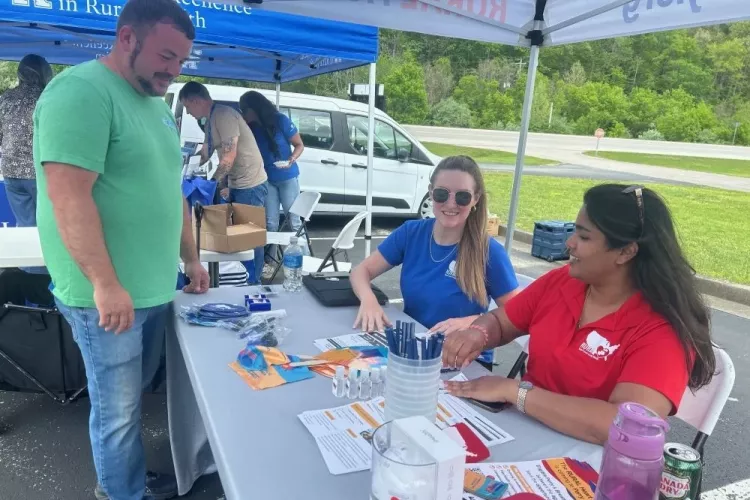UofL, partners urge action to address threats to the Ohio River Basin
Public invited to comment until July 18 June 6, 2025
The public is invited to weigh in on a draft plan to restore and protect the waters that 30 million people depend on for their drinking water, public health and quality of life in the Ohio River Basin. Released by the University of Louisville’s Christina Lee Brown Envirome Institute, Ohio River Basin Alliance and National Wildlife Federation, the plan aims to tackle serious problems such as toxic pollution, sewage contamination, habitat loss, mine waste and flooding.
The Ohio River Basin covers a region of 204,000 square miles, consisting of the ancestral and historical homelands of more than 40 federally recognized Tribal Nations, as well as those of the Tribal Nations currently within the basin, the Eastern Band of Cherokee Indians and the Seneca Nation of Indians. The Basin encompasses portions of 14 states including Alabama, Georgia, Kentucky, Illinois, Indiana, Maryland, Mississippi, New York, North Carolina, Ohio, Pennsylvania, Tennessee, Virginia and West Virginia.
The draft report, “Healthy Waters, Healthy Communities, Healthy Economies: A Collaborative Plan to Restore and Protect the Waters of the Ohio River Basin,” seeks to address several threats to local waters including inadequate water infrastructure, toxic pollution, nonpoint source pollution, mining issues, hydrologic modification, loss of habitat, invasive species and extreme weather and flooding.
“Everyone deserves access to clean, safe and affordable water, yet too many communities continue to have to worry about their children’s and seniors’ health due to point and non-point source impacts of their ground water and recreational waterways,” said Ted Smith, director of the Center for Healthy Air, Water and Soil, a part of UofL’s Christina Lee Brown Envirome Institute. “We see this as an important and needed step to make communities healthier, safer and more prosperous. Combined with other efforts, restoration investments can ultimately contribute to better health outcomes for people in the region.”
The Envirome Institute, in particular the Center for Healthy Air, Water and Soil, contributed substantial content to the report, with a focus on the importance of restoration of the Ohio River Basin as part of supporting community health. UofL faculty led the environmental human health risk analysis in the plan, building off their previously published work on environmental vulnerability analysis and the place-based health framework in place at UofL.
Among concerns raised by Envirome are the 327 Superfund sites within the basin that have yet to be fully remediated. With historic flooding in Kentucky in recent years, these sites put our water system at risk for increased pollution. Additional issues include agricultural system runoff and heavy metals contamination related to power generation.
“One recent development is the great pressure being placed on fresh water sources in the basin to cool large-scale data centers. Clean water has never been more important to the health and security of this basin,” Smith said.
Comments on the report can be submitted online here through July 18. A public engagement session will be held in Louisville June 25, 6-7:30 p.m. at St. Matthew’s Episcopal Church, 330 North Hubbards Ln. Additional opportunities can be found on the project website, including in-person events across the region and a public webinar on June 12.
“We all have a role to play in the restoration and protection of the natural resources that make this region such a special place,” said Harry Stone, past chair of the Ohio River Basin Alliance. “Through collaboration and trust we are putting together a roadmap to improve our environment, our health and our local economies. By continuing to work together, we can secure a healthier environment and a better future for all of the people who call this region home.”
Once finalized, the report will be provided to members of Congress.
Background
Despite progress over the past 50 years to restore the region’s waters by local, state, Tribal and federal partners, serious threats remain: 69 percent of assessed stream miles and 64 percent of lakes in the region do not meet water quality standards due to a variety of pollutants. The report provides a case statement for increased collaboration with, and engagement by, the federal government to accelerate progress in addressing water quality concerns. The report recommends:
- Increasing federal investment in proven restoration actions
- Increasing monitoring and research to guide future actions
- Increasing coordination across the region to manage ecosystems holistically
- Increasing technical assistance to ensure local communities benefit from restoration actions
The plan supports solutions for cleaning up pollution, reducing runoff, restoring wildlife habitat, modernizing water infrastructure, mitigating the impacts of floods and the prevention of non-native, invasive species.
Related News



